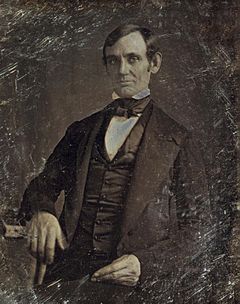
Back Daguerreotipe Afrikaans Daguerreotype ANG داجيرية Arabic Daguerrotipu AST Dagerotipiya Azerbaijani Дагератыпія Byelorussian Дагеротипия Bulgarian দাগেরোচিত্র Bengali/Bangla Daguerreotip Catalan Daguerrotypie Czech

Daguerreotype (/dəˈɡɛər(i.)əˌtaɪp, -(i.)oʊ-/ ⓘ;[1][2] French: daguerréotype) was the first publicly available photographic process; it was widely used during the 1840s and 1850s. "Daguerreotype" also refers to an image created through this process.
Invented by Louis Daguerre and introduced worldwide in 1839,[3][4][5] the daguerreotype was almost completely superseded by 1856 with new, less expensive processes, such as ambrotype (collodion process), that yield more readily viewable images. There has been a revival of the daguerreotype since the late 20th century by a small number of photographers interested in making artistic use of early photographic processes.[6]

To make the image, a daguerreotypist polished a sheet of silver-plated copper to a mirror finish; treated it with fumes that made its surface light-sensitive; exposed it in a camera for as long as was judged to be necessary, which could be as little as a few seconds for brightly sunlit subjects or much longer with less intense lighting; made the resulting latent image on it visible by fuming it with mercury vapor; removed its sensitivity to light by liquid chemical treatment; rinsed and dried it; and then sealed the easily marred result behind glass in a protective enclosure.
The image is on a mirror-like silver surface and will appear either positive or negative, depending on the angle at which it is viewed, how it is lit and whether a light or dark background is being reflected in the metal. The darkest areas of the image are simply bare silver; lighter areas have a microscopically fine light-scattering texture. The surface is very delicate, and even the lightest wiping can permanently scuff it. Some tarnish around the edges is normal.
Several types of antique photographs, most often ambrotypes and tintypes, but sometimes even old prints on paper, are commonly misidentified as daguerreotypes, especially if they are in the small, ornamented cases in which daguerreotypes made in the US and the UK were usually housed. The name "daguerreotype" correctly refers only to one very specific image type and medium, the product of a process that was in wide use only from the early 1840s to the late 1850s.
- ^ Jones, Daniel (2003) [1917]. Peter Roach; James Hartmann; Jane Setter (eds.). English Pronouncing Dictionary. Cambridge: Cambridge University Press. ISBN 3-12-539683-2.
- ^
- "daguerreotype". Merriam-Webster.com Dictionary.
- "daguerreotype". Dictionary.com Unabridged (Online). n.d.
- "daguerreotype". The American Heritage Dictionary of the English Language (5th ed.). HarperCollins.
- ^ Lowry, Bates; Barrett Lowry, Isabel (2000). The Silver Canvas: Daguerreotype Masterpieces from the J. Paul Getty Museum. Getty Publishers. p. 12. ISBN 0-89236-536-6.
- ^ Curley, Robert, ed. (2010). The 100 Most Influential Inventors of All Time. The Rosen Publishing Group. p. 77. ISBN 978-1-61530-003-7.
- ^ "History of photography: Daguerreotype". Encyclopedia Britannica. Retrieved 11 January 2022.
© MMXXIII Rich X Search. We shall prevail. All rights reserved. Rich X Search